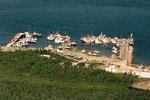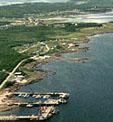

Main Presentation
Pubnico Photo Tour
Acadie Links
Important links related to
World Acadian Congress
July 31 to August 15, 2004
The Acadian
Museum
The
Acadian Village
The Acadian
Festival
Ted D'Eon's Pages
Excellent site lots of
interesting reports and information.
Beans Handmade Creations
by Pierrette d'Entremont
Yarmouth Communities Index
Pubnico Photo Tour <ENTER>
Pubnico derives its name from the Mi'kmaq word meaning "cleared land". Settled in 1653 by Acadians, these villages (West Pubnico, Middle West Pubnico and Lower West Pubnico) make up the oldest Acadian settlement in the province. They rely on the sea for their livelyhood, and the area maintains several wharves, breakwaters, fishing fleets, and fish processing plants.
 Dennis
Point wharf is the home to a multi million dollar fishing fleet, sheltered
in the harbour where the West Pubnico arm juts into the sea.
Dennis
Point wharf is the home to a multi million dollar fishing fleet, sheltered
in the harbour where the West Pubnico arm juts into the sea.
The "Musee Acadien" is located right across from the West Pubnico Fire Department . It is an Acadian home built in 1864, featuring household items, maps, and original land grants for the area from the late 1700's; also a collection of 325 cameras. It tells the tales of the early settlement life, the Expulsion, and of those who returned to pick up the pieces of their language and culture afterwards.
Other attractions in the area are: a 70-year-old Lighthouse attached to a craft shop, an 18 hole golf course, the Mill Stones at Middle West Pubnico, the Lighthouse Park, and many other wonderful things to see.
There is also the festival "Chez
Nous a Pombcoup" every August (early in the month)! And in the Planning
is the "Village Acadien".
A Brief History
The Pubnicos (Y) : Southeast of Yarmouth, there are at least 15 distinct communities that incorporate the name "Pubnico". One of the oldest European settlements in the province, this area was included in the barony of Pobomcoup granted to Phillipe Mius d'Entremont (ca. 1601-1700) in 1653 by Charles de Saint-Etienne de La Tour (1593-1666). The Pubnico's escaped the first wave of expulsion in 1755; their turn came in 1758-59. A few people escaped deportation and because these particular lands were never occupied by others, the majority of the exiled returned in the 1760s. The name is derived from the Mi'kmaq "Pogomkook" of uncertain meaning. The earliest French form "Pobomcoup", is from which modern spelling has evolved. The barony remained in the d'Entremont family until the expulsion; after more than 3 centuries, some 100 families of this name may be counted in the Pubnicos. Simon d'Entremont was elected MLA for Argyle in 1836, on of the first 2 Acadians to achieve this honor. A second Acadian, Frederic Robichau (ca. 1786-1863), was also elected in Annapolis; however, he was ill and missed the swearing in ceremony of the 15th assembly on 31 January 1837. Pobichau was unable to take his seat until the next session, thus making d'Entremont the first Acadian legislator.
*from the book "Place Names of Atlantic
Canada" Ref 917.16 HAM in the Western Counties Regional Library*
The Pubnicos (Y) : Named from the Indian word "Pogomkook", meaning "land from which the trees have been removed to fit it for cultivation". The old French spelling was "Pombomcoup" from which the transition to "Pubnico" was easy. It is also stated that it was called "Poubomcoup", after a French family of that name who lived there or thereabouts in 1705, but it is more likely that the Indian derivation is the correct one. Of the Indian word "Bagbumkook" we find the following English and French variations "Pommicoup", "Poumicoup", "Pobomcon", "Pignico", and "Pubnico". Phillipe Mius d'Entremont was made "Baron of Poboncon" by Charles de La Tour, who was himself known as "Lord of Cape Sable" and "Lt. of the King in Acadia". It had been settled by d'Entremont and other French immmigrants he brought over in 1650.
*from the book "Place Names of the Province
of Nova Scotia"Ref 917.15 BRO in the Western Counties Regional Library*
